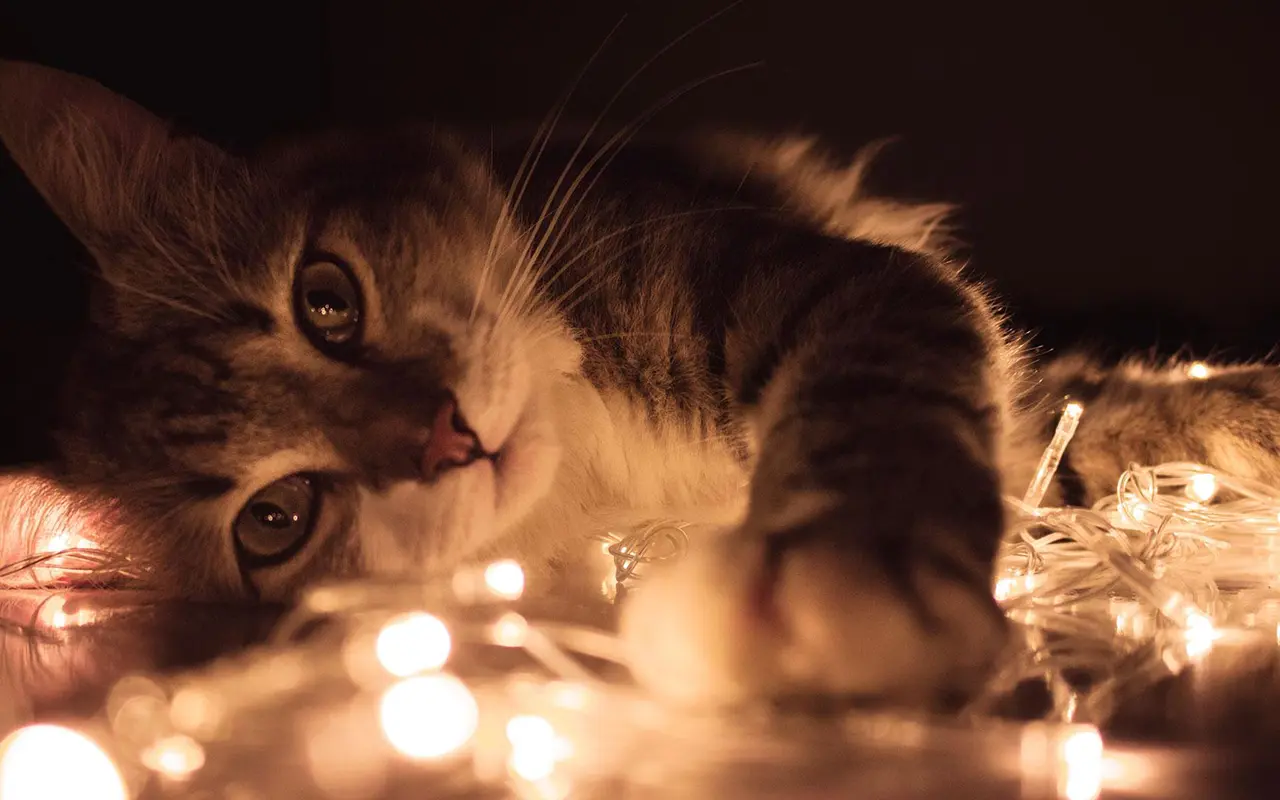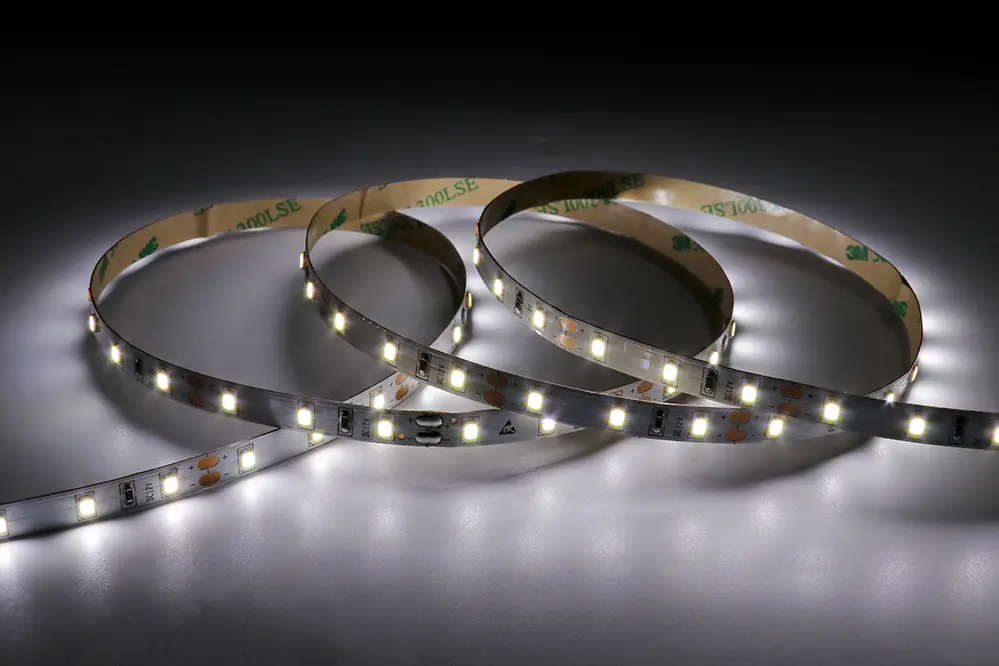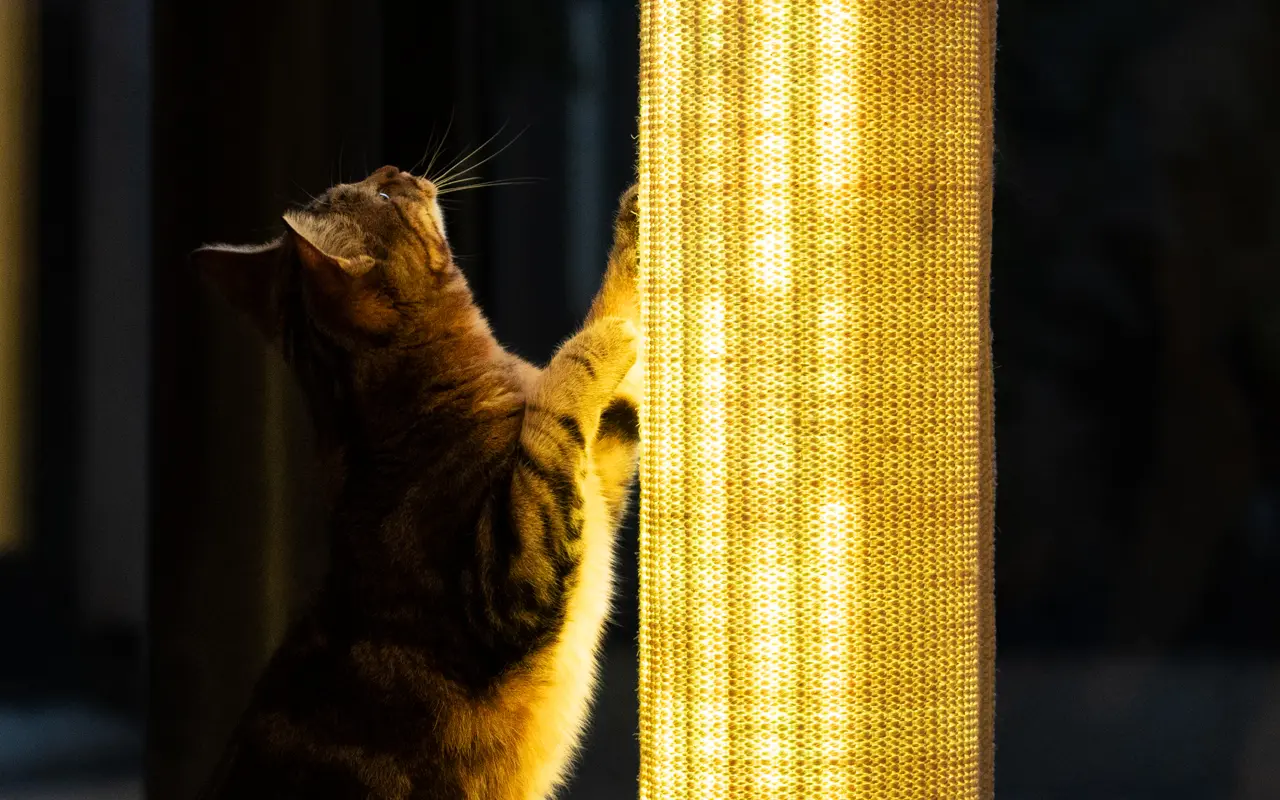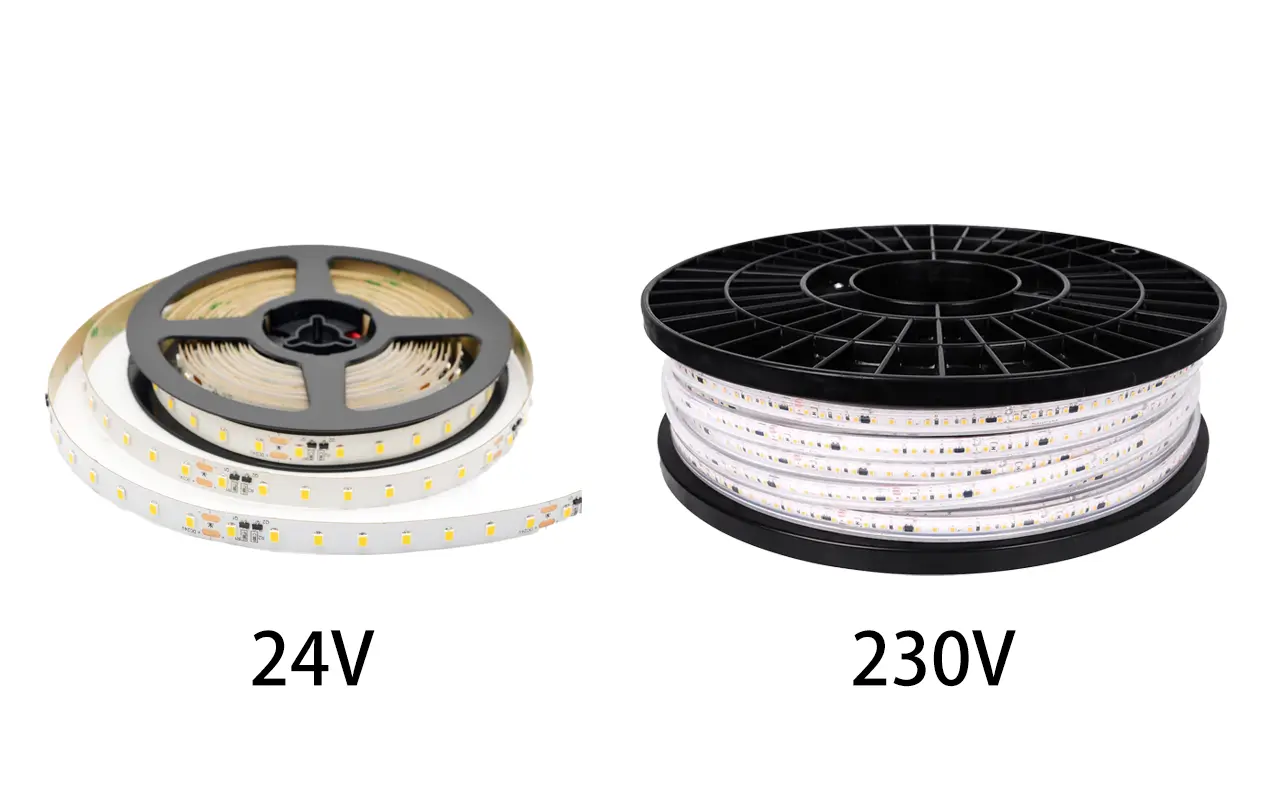特に、愛するネコ科の動物や、現代の照明ソリューションとの相互作用に関わる場合はなおさらです。LEDストリップ照明とその猫への影響に関する包括的な洞察と実践的なアドバイスを得るには、このサイトが最適です。
LEDストリップライトは、そのエネルギー効率と多用途性から高く評価されていますが、一般的に猫にとって安全です。しかし、これらの照明ソリューションが猫の健康と幸福に悪影響を及ぼさないようにするには、その光強度、色スペクトル、適切な設置方法を理解することが重要です。
猫に関するLED照明のニュアンスをより深く掘り下げ、私たちと一緒に旅に出かけましょう。あなたの家の照明と三毛猫のニーズを調和させ、明るい環境での快適性と安全性を確保するための、オーダーメイドの戦略と専門家のヒントをご覧ください。
LED照明への洞察:ネコの安全確保
LED技術を分解する:猫の飼い主が知っておくべきこと
LED照明は、家庭からオフィス、さらには道路に至るまで、あらゆるものを照らし出し、私たちの生活に浸透している。しかし、これは私たちが世話をしている人間以外の目、特に私たちの愛するネコの目にとってどのような意味があるのだろうか?
LED技術を理解することは、猫の飼い主にとって不可欠である。LED(発光ダイオード)は、電流が流れることで発光する半導体デバイスです。従来の白熱電球とは異なり、LEDは発熱するフィラメントに頼らずに発光するため、ペットの安全を確保する上で極めて重要な熱の発生が少ない。
さらに、LEDはその効率と寿命で知られているが、ネコの視点から精査する必要があるのは、その光量と色スペクトルである。猫の視覚システムは人間とは異なる。そのため、照明の明るさの変化に非常に敏感で、人工光源による不快感を感じやすいのだ。
これらの原則を理解することで、猫の飼い主は家庭内の照明について十分な情報を得た上で決定することができます。単に明かりを与えるだけでなく、猫の本能とニーズを尊重した環境を作ることが大切なのだ。
ネコちゃんのためにLEDを選ぶ
猫と共有する空間にLED照明を選ぶとなると、いくつかの要素が絡んできます。LED照明の色温度はケルビン(K)で表され、暖色系の黄色から寒色系の青色まであります。研究によると、猫にとっては暖かみのある低ケルビンの照明の方が快適で、三白眼の生き物が最も活発に活動する夜明けや夕暮れの色を模倣しています。
また、LED照明の調光機能も重要です。特に敏感な猫や健康上の問題を抱えている猫にとって、照明が急に変わると驚いたり、不快に感じたりすることがあります。調光機能付きLEDなら、猫の行動や時間帯に合わせて明るさを調節でき、より自然で邪魔にならない照明環境を提供できます。
さらに、LEDライトの配置は戦略的に行う必要があります。猫がよく出入りする場所や寝る場所には、強い光を直接当てないようにしましょう。その代わりに、空間を優しく均一に照らすアンビエント照明を目指し、ペットの邪魔になるようなきつい影や明るい場所を減らしましょう。
まとめると、LED照明はエネルギー効率と寿命の面で多くの利点を提供するが、猫同居の家庭で使用するには、猫に特有の感覚を十分に考慮する必要がある。適切な色温度と調光機能を持つLEDを選択することで、猫の飼い主は猫の友人の快適さと幸福感を大幅に向上させることができ、照明の選択がすべての住人にとって調和のとれた生活環境をサポートすることを保証することができる。
ネコの視覚とLEDの相互作用:批判的分析
猫の視力を理解する:家庭の照明に合わせる
猫は夜行性の捕食者という役割に高度に適応した視覚を持っており、人間が必要とする光量の6倍も低い光量でも見ることができる。しかし、この驚異的な感度は、家庭用照明が猫の快適さやストレスレベルに思わぬ影響を及ぼす可能性があることを意味します。LED照明は、省エネと長寿命には有益ですが、猫の目が最適に同調する自然の太陽光とはまったく異なるスペクトルの光と強さを放ちます。
私たちの住まいをより快適なものにするためには、ネコの目は特に動きに敏感で、照明のわずかな変化も感知することを理解することが重要です。この敏感さゆえに、特定のLED設定、特にちらつきや急激な変化は、不安感を与えたり、時間が経つにつれて有害になる可能性さえある。このようなネコ特有の感受性の強さに対応するためには、出力が安定したLEDを選び、敏感なネコのストレス反応を引き起こす可能性のある急激なフリッカーを避ける必要があります。
さらに、色温度と明るさを考慮することも重要です。猫は人間と同じように色を知覚することはできませんが、光量の変化を感知することができるため、屋外のダイナミックな照明条件に近い環境を好むことがあります。そのため、夜明けや夕暮れ時のような、暖かみのある柔らかな光を提供するLEDを選ぶと、ネコの仲間にとってより自然で快適な環境を作り出すことができます。
猫の快適性と健康のためのLED照明の最適化
猫にやさしい照明環境づくりは、LED電球の選定だけにとどまりません。猫の快適さと健康を確保するためには、照明の配置とコントロールも同様に重要です。LED照明を愛猫に最適化するには、愛猫が最も長い時間を過ごす場所を考慮し、それに合わせて照明を調整します。例えば、猫のお気に入りの休憩場所の真上や、猫がよく使う通路沿いには、明るいLEDを置かないようにしましょう。
調光可能なLEDは特に有益で、猫が活発に活動する薄明かりの時間帯に明るさを抑えることができ、屋外での自然な減光を模倣することができます。さらに、タイマーやスマートホームシステムを取り入れて照明を徐々に調整することで、猫の自然な概日リズムを尊重した一貫性のある環境を維持することができます。
LED照明の設定や設置場所を工夫することで、猫の不快感やストレスを最小限に抑えることができます。目標は、猫の健康と幸福をサポートする照明環境を作り、屋内のテリトリーで安心し、リラックスできるようにすることです。よく考え、調整することで、LED照明の利点を生かしながら、ネコちゃんの自然な行動や好みを補うことができます。
猫に安全なLED使用のための実践的ステップ
ペットオーナーのためのインストールと設定のヒント
LED照明に照らされた環境において、ネコちゃんの安全性と快適性を確保するためには、入念な設置・設定が必要です。どの猫にも独特の習性や好みがあることを認識し、LEDストリップライトの配置や設定が猫の日常生活にどのような影響を与えるかを考慮することが重要です。例えば、人通りの多い場所に設置するLED照明は、猫を驚かせたり、強烈な明るさで圧倒したりしないよう、柔らかく拡散した光を放つようにします。
LEDライトを設定する際は、調整可能でプログラム可能なオプションを選ぶと便利です。このような機能を使えば、1日のさまざまな時間帯に合わせて照明を調整し、猫の自然な行動パターンに合わせることができます。例えば、夕方の時間帯に照明をソフトにすれば、夕暮れをシミュレートすることができ、夜行性の猫にとって快適な時間を過ごすことができます。
さらに、LEDを設置する高さや角度も考慮しましょう。猫の目の高さに設置したり、お気に入りの休憩スポットに向けたりする照明は、直射日光を避けるべきです。代わりに、ペットに不必要なストレスや注意散漫を与えることなく、雰囲気を高める間接照明を目指しましょう。
LED露出のモニタリングと調整
猫が空腹や苦痛のサインを出していないか観察するのと同じように、家庭用照明の変化に対する反応を観察することも重要です。LEDライトを設置した後、新しい照明に不快感を示すような猫の行動や機嫌の変化がないか観察しましょう。目を細めたり、特定の場所を避けたり、睡眠パターンが変化したりといった兆候は、照明がペットにとって最適でないことを示唆しています。
愛猫の健康と幸福をサポートする環境を維持するためには、家庭内のLED照射量を定期的に調整することが重要です。これは、猫の典型的な休息時間帯に照明を暗くしたり、色温度を変えて強さを感じにくくしたりすることを意味します。複数のペットがいるご家庭や、特に敏感な猫がいるご家庭では、家族全員に合うバランスが見つかるまで、さまざまな設定を試してみる価値があります。
LED照明を住まいに取り入れる目的は、単に照明としてだけでなく、ペットを含むすべての居住者の生活空間を向上させることであることを忘れないでください。LED照明を慎重に設置し、猫の反応を観察し、必要な調整を行うことで、照明の選択が猫の幸福にプラスに働き、家の中の安全性と快適性が強化されます。
よくあるご質問
LEDストリップライトは、従来の電球と比べて猫にとって安全か?
そう、LEDストリップライトは熱の放出が少なく火傷の危険性が低いため、一般的に猫にとって安全であり、ペットのいる家庭で好まれる選択肢となっている。
LEDライトの色温度は猫の機嫌に影響しますか?
その通りだ。猫は環境に敏感で、LEDライトの暖色系の色温度はより快適な雰囲気を作り出しますが、寒色系は猫にとって居心地が悪いかもしれません。
夜間、猫のためにLEDストリップライトを点けっぱなしにすべきでしょうか?
猫のためにLEDライトを一晩中つけっぱなしにする必要はない。猫の夜間視力は優れており、暗い場所でもよく見えます。しかし、薄暗く暖かい光であれば、猫の自然な行動を妨げることなく、快適さを与えることができます。
猫は特定の色のLEDライトを好むのか?
猫は人間と同じように色を知覚するわけではないが、真っ白な光や青い光とは対照的に、自然光を模した暖色系の光(柔らかい黄色など)の方が落ち着くのかもしれない。
LEDストリップライトを猫用に調整するには?
調光可能なLEDを使って明るさを調節し、色温度を調節できる照明も検討しましょう。また、猫の目に直接光が当たらないよう、照明を戦略的に配置しましょう。
点滅や点滅するLEDライトは猫にとって安全ですか?
LEDライトの点滅や点滅は、猫が驚いたり不快に感じたりする可能性があるため、避けたほうがよい。一貫性のある安定したライトの方が猫に優しい。
LEDストリップライトは猫の不安解消に役立ちますか?
LEDストリップライトは適切に使用することで、落ち着いた環境を作ることができる。ソフトで温かみのある照明は、安心感を与え、不安を和らげる可能性がある。
猫のトイレや餌場と同じ部屋にLEDストリップライトを置くことは有害ですか?
LEDライト自体に害はありませんが、猫が食事をする場所やトイレを使用する場所では、猫の快適さとプライバシーを保つために、よりソフトで薄暗いライトを使用することを検討してください。
LED照明が猫に悪影響を及ぼしているかどうかを知るには?
猫の行動を観察する。目を細めたり、明るい場所を避けたり、行動が変わったりすることがあります。照明を調節して行動が変わるかどうか確認することで、原因を特定することができます。
LEDライトの寿命が長いことは、飼い猫に何かメリットがあるのでしょうか?
LEDライトは耐久性に優れ、交換の頻度も少ないため、猫の環境を乱すことが少なく、家での安心感や安定感を高めることができます。
安全性を優先しつつLED照明の利点を強調
LED照明は、エネルギー効率と寿命の長さを筆頭に、その無数の利点が高く評価されている。これらの特性は、LED照明が住宅所有者にとって費用対効果の高い選択肢となるだけでなく、環境フットプリントの低減にも貢献する。しかし、猫がいる家庭では、LED照明の導入には、猫の安全性と快適性を確保しながら、これらの利点を生かすための慎重なアプローチが必要です。
LED照明の効率の良さは、電気を熱ではなく光に変換する割合が高いことに起因しており、ペットのいる家庭では特に重要だ。従来の電球は発熱量が多く、暖かさに引き寄せられた好奇心旺盛な猫が火傷をする危険性がある。対照的に、LEDの低温動作はそのようなリスクを最小限に抑え、ペットと共有する環境ではより安全な選択肢となる。
さらに、LED照明の寿命の長さも特筆すべき点で、電球交換の頻度を減らすことができます。猫の飼い主にとっては、ペットの環境を乱すことが少なくなり、交換時に猫が照明器具の小さな部品に触れる機会も減る。この点は、ガラス電球よりも割れにくいLEDの耐久性と相まって、猫のいる家庭での安全面でのメリットをさらに際立たせている。
しかし、猫の安全を最優先しながらLED照明の利点を真に生かすには、光の色、温度、強さなどの要素を考慮することが不可欠です。温かみのある柔らかな光を放つLEDを選べば、習性の生き物として環境の変化に敏感な猫にとって、より快適でストレスのない空間を作り出すことができます。さらに、明るさを調節できるLEDを選べば、猫の行動パターンや好みに合わせた照明計画を立てることができ、猫が家の中で安心してくつろげるようになります。
まとめると、省エネと長寿命というLED照明の利点は確立されているが、猫のいる家庭での導入は、安全性と快適性に留意して行う必要がある。適切なLED製品を選び、その配置や設定に気を配ることで、猫の飼い主は愛するペットの健康を損なうことなく、最新の照明技術の利点を享受することができる。
まとめ:LEDの利点と猫の福祉の調和
結論として、LEDストリップライトは美観と実用性の両方を提供する、どの家庭にとっても素晴らしい付加物である。しかし、その使用にあたっては、常に愛猫の健康と幸福に配慮する必要がある。このガイドで紹介したことを理解し、実践することで、LED照明の利点を享受しながら、猫友にとって安全で快適な環境を作ることができる。
LEDストリップライトは家庭の照明として無数の利点を提供しますが、ネコの友だちの健康との適合性が最も重要です。猫にとって安全で快適な環境を確保するためには、信頼できるプロバイダーから照明ソリューションを調達することが重要です。入る ユニトップを製造する中国有数のメーカーである。 LEDストリップライト そして LEDネオンフレックス品質とイノベーションへのコミットメントで有名です。安全でスタイリッシュな照明ソリューションに関するご質問や具体的なご要望は、下記までお気軽にお問い合わせください。 ユニトップに連絡.LED業界における彼らの専門知識は、顧客満足とペットの安全への献身を証明するものです。今すぐユニトップとお付き合いいただき、この分野のリーダーを選んだという自信をもって、ご自宅を照らしてください。
関連記事

トムは現在、セールスマネージャーとして ユニトップ(中国)有限公司.になっているそうです。 LED照明 2005年入社。セールス&マーケティング、工場管理の専門家である。ボディビルが好きで、熱狂的なアップルファンでもある!努力家で、新しいことを学び、試すのが大好きです。
電子メール tom@unitopledstrip.com WhatsAppです: +86-18680307140







返信を残す
ディスカッションに参加したい方はこちらお気軽にご投稿ください!